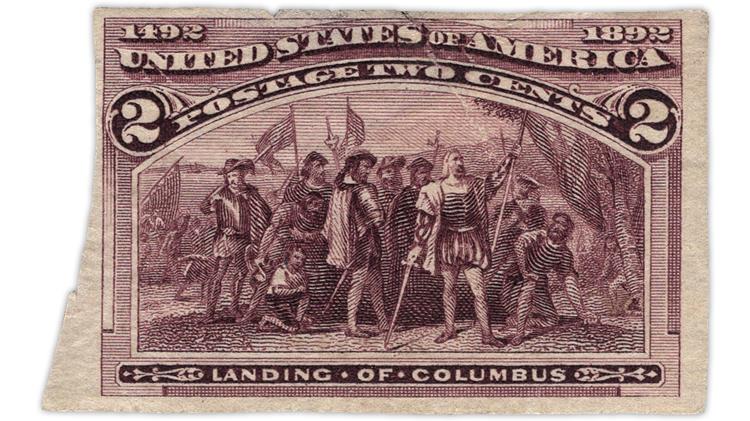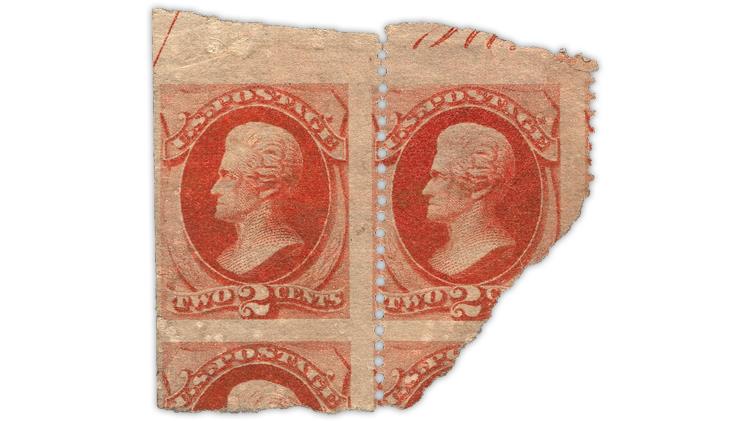US Stamps
Printer’s waste varies as to cause and effect
U.S. Stamp Notes by John M. Hotchner
“Printer’s waste” is a broad term covering a multitude of sins involving stamp production. For example, it can include incomplete product, defective stamps with many flaws (often referred to as errors, freaks and oddities, or EFOs), damaged material, and unsuccessful printing experiments.
The vast majority of this material is caught in the printing plant and sent for destruction, either in-house or off-site. But it is inevitable, given the billions of stamps printed per year, that some waste will escape destruction and be sold to postal customers. There also is the constant threat of employee theft of EFOs and other waste that might be sold for substantial sums to stamp dealers or collectors. Let’s look at four examples of printer’s waste in this column. The first is the imperf 1893 Columbian 2¢ in Figure 1. The basic perforated stamp is Scott 231.
Stanley Segal described the origin of Columbian imperfs in his 1979 book Errors, Freaks and Oddities on U.S. Stamps: Question Marks in Philately: “The 2c Columbian stamp is catalogue-listed in a completely imperforated condition. These stamps are found in very poor condition, creased and stained, and with no gum. It is thought that they were recovered from paper scrap sold by the American Bank Note Company to waste paper dealers. These imperforates were never sold over a post office counter, but for some reason they have been afforded catalogue recognition.”
It should be noted that the Scott U.S. Specialized and Standard catalogs no longer list these imperfs, nor are they listed in the Scott Catalogue of Errors on U.S. Postage Stamps.
A long article by Thomas Corette in the 2008 Congress Book seeks to get to the bottom of the origin of the 2¢ Columbian imperfs. He retells the story of some sailors who sold a trunk full of stamps to a stamp dealer named Proskey, who discovered a partial sheet of 2¢ Columbian imperfs in a crumpled ball.
This is not inconsistent with the Segal story, but either may be accurate or not.
What is clear is that there are many examples known of these imperfs, but none are documented as being sold over a post office counter. Also, all known examples have a series of relief breaks (thins or gaps) in the lower right frameline.
Corette concluded that “Since only 75 positions have been identified, there is a strong possibility that only one sheet of a 100-subject plate was the source of the imperforates.”
An earlier piece, the 1875 2¢ orange Andrew Jackson (Scott 178), is shown in Figure 2. It is poorly perforated vertically and imperforate horizontally. Imperfs are not listed in the Scott Specialized Catalogue of United States Stamps and Covers, so this chunk may be ...
To continue reading, subscribe to Linn’s Stamp News.
Connect with Linn’s Stamp News:
Sign up for our newsletter
Like us on Facebook
Follow us on Twitter
MORE RELATED ARTICLES
Headlines
-
US Stamps
Oct 7, 2024, 12 PMVasiliauskas named president of Mystic Stamp Co.
-
US Stamps
Oct 6, 2024, 5 PMApgar souvenir card available
-
US Stamps
Oct 6, 2024, 4 PMFirst Continental Congress and U.N. stamps receive Scott catalog numbers
-
World Stamps
Oct 5, 2024, 1 PMCanada Post continues Truth and Reconciliation series










